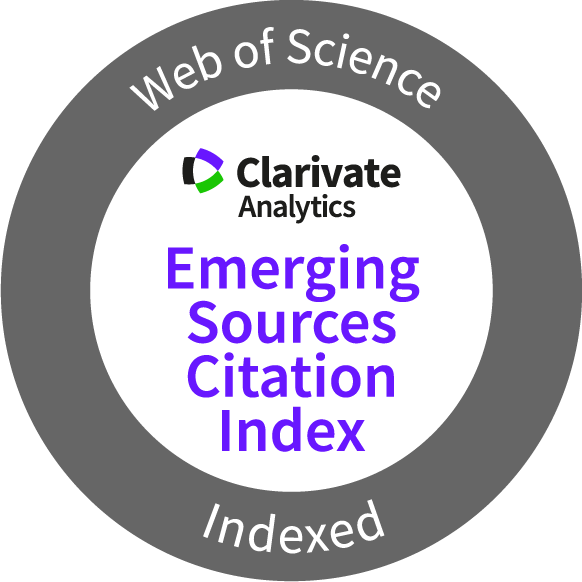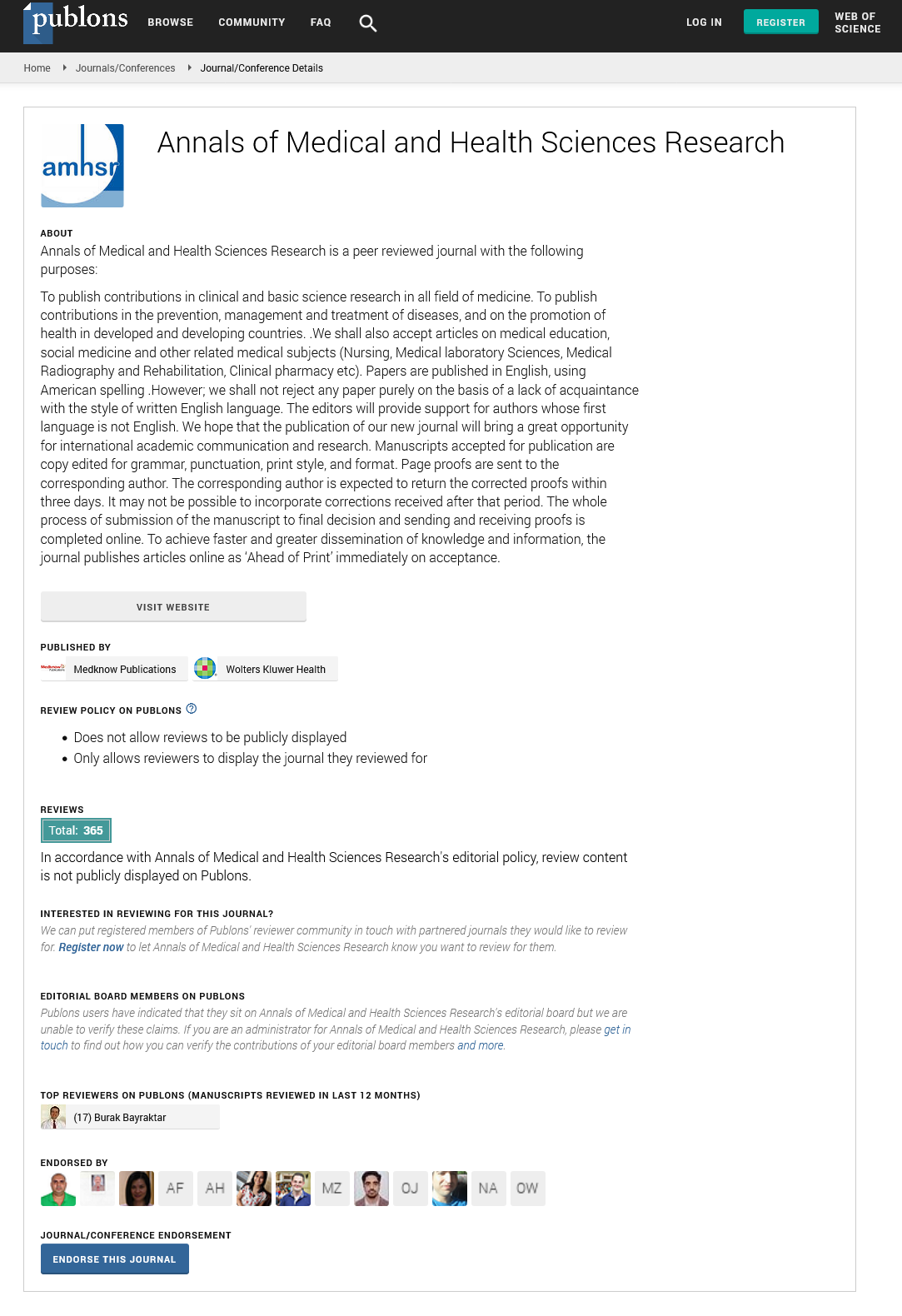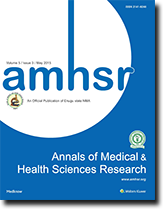Evaluation of Postpartum Haemorrhage Management in the Dominican Republic: A Cross-Sectional Study
Received: 08-Oct-2024, Manuscript No. amhsr-24-149885; Editor assigned: 10-Oct-2024, Pre QC No. amhsr-24-149885 (PQ); Reviewed: 24-Oct-2024 QC No. amhsr-24-149885; Revised: 31-Oct-2024, Manuscript No. amhsr-24-149885 (R); Published: 07-Nov-2024
Citation: Pérez D YR. Evaluation of Postpartum Hemorrhage Management in the Dominican Republic: A Cross-Sectional Study. Ann Med Health Sci Res. 2024; S4:1-3.
This open-access article is distributed under the terms of the Creative Commons Attribution Non-Commercial License (CC BY-NC) (http://creativecommons.org/licenses/by-nc/4.0/), which permits reuse, distribution and reproduction of the article, provided that the original work is properly cited and the reuse is restricted to noncommercial purposes. For commercial reuse, contact reprints@pulsus.com
Abstract
Objective: This study aims to evaluate the management of Postpartum Hemorrhage (PPH) in the Dominican Republic, focusing on the assessment of clinical training and the availability of resources within maternal health contexts.
Design: A cross-sectional study design was employed to gather comprehensive data on the current state of PPH management practices.
Setting: The research was conducted across both public and private hospitals located in the Dominican Republic, providing a diverse range of perspectives on healthcare delivery.
Population: A total of 500 participants were included in the study, comprising obstetricians and gynecology residents who are directly involved in maternal healthcare.
Methods: Participants completed a structured survey designed to assess their practices related to PPH management, the availability of necessary resources and their training experiences. Descriptive statistics were utilized to analyze the collected data, offering insights into the current challenges faced in managing PPH.
Main outcome measures: The primary outcomes measured included the level of clinical training in managing obstetric emergencies, the availability of essential resources for effective PPH management and the perceived importance of a multidisciplinary approach in addressing PPH cases.
Results: The findings revealed that 45% of respondents felt inadequately trained to manage PPH effectively, highlighting a significant gap in clinical education. Additionally, only 30% of the surveyed hospitals reported having access to bakri balloons, an important tool for managing severe PPH. Moreover, 60% of the participants indicated that oxytocin was utilized as their first- line uterotonic agent for treatment. Notably, 80% of respondents emphasized the important importance of adopting a multidisciplinary approach to enhance outcomes in PPH management.
Conclusion: The study identified substantial deficiencies in both clinical training and access to essential resources necessary for effective PPH management in the Dominican Republic. Addressing these gaps is essential for improving the management of postpartum hemorrhage and ultimately reducing maternal mortality rates in the region.
Keywords
Postpartum; Maternal; Mortality; Hemorrhage
Introduction
Postpartum Hemorrhage (PPH) is a serious and potentially life threatening condition that occurs when a woman loses more than 500 ml of blood after vaginal delivery or over 1,000 ml following a cesarean section, typically occurring within the first 24 hours post delivery. It is categorized into two types: Primary PPH, which occurs within the first 24 hours and secondary PPH, which occurs from 24 hours to 12 weeks postpartum. The most common cause of primary PPH is uterine atony, a condition where the uterus fails to contract effectively, leading to excessive bleeding. Other significant contributors include retained placental tissue, trauma to the birth canal and coagulation disorders. Uterine atony accounts for approximately70% of PPH cases, making it essential for healthcare providers to recognize and manage this condition swiftly. In addition to uterine atony, retained placental tissue can prolong bleeding and complicate recovery. Effective management of PPH necessitates a thorough understanding of the underlying causes, rapid assessment of the patient's condition and immediate intervention [1,2].
First line treatments for PPH include the administration of uterotonics, such as oxytocin, which help stimulate uterine contractions and reduce bleeding. In cases where oxytocin is ineffective or unavailable, alternative uterotonics like methylergometrine and carboprost may be utilized. When medical management fails to control bleeding, mechanical interventions such as balloon tamponade can be employed [3]. The bakri balloon, for instance, is inserted into the uterus and inflated to provide compression and control hemorrhage. Surgical options, including uterine artery ligation or hysterectomy, may be necessary in severe cases to preserve maternal life. In addition to medical and surgical interventions, supportive care is important in managing PPH. Blood transfusions and Intravenous (IV) fluids are often required to restore circulating volume and stabilize the patient, particularly in severe cases where blood loss is significant. Close monitoring of vital signs and blood loss is essential to ensure timely interventions.
Developing countries like the Dominican Republic face unique challenges in managing PPH, where maternal mortality rates remain alarmingly high [3]. These challenges stem from a lack of resources, inadequate training among healthcare providers and delays in accessing emergency care. Many hospitals struggle with insufficient supplies of uterotonics, blood products and other essential resources, which can delay important interventions and worsen patient outcomes. Moreover, there is often a significant gap in clinical training, with many healthcare providers feeling inadequately prepared to handle obstetric emergencies such as PPH. This lack of training can lead to uncertainty and hesitation in managing these important situations, resulting in increased maternal morbidity and mortality [4].
Given the high prevalence of PPH and its implications for maternal health in the Dominican Republic, it is essential to evaluate and improve clinical training, enhance resource availability and implement standardized protocols for PPH management. This study aims to assess current practices in Dominican hospitals, highlighting the gaps in knowledge and resource limitations that hinder effective management of PPH, ultimately contributing to efforts to reduce maternal mortality rates in the region. Addressing these issues through comprehensive education and improved healthcare infrastructure will be vital in saving lives and enhancing maternal health outcomes in the Dominican Republic [5,6].
Materials and Methods
Design
This was a cross-sectional study conducted through a survey administered to 500 healthcare professionals, including obstetricians and gynecology residents, working in public and private hospitals across the Dominican Republic.
Setting
The study was conducted in public and private hospitals across the country. Hospitals were selected to represent urban and rural areas, ensuring the inclusion of facilities with varying levels of resource availability [7].
Participants
A total of 500 healthcare providers, including obstetricians and gynecology residents, were included in this study. Participants were selected based on their involvement in the management of obstetric emergencies, particularly PPH.
Data collection
A structured survey was designed to evaluate the respondents’ self-reported training in managing PPH, the availability of resources (e.g., uterotonics and bakri balloons) and their experience with multidisciplinary care for PPH. The data were analyzed using descriptive statistics, focusing on the frequency and percentage of responses [8].
Results
Training
A total of 45% of participants reported insufficient training in PPH management, highlighting the need for better education and clinical preparation in obstetric emergencies. Participants expressed concerns about their ability to handle severe hemorrhagic cases, particularly in high-risk pregnancies.
Resource availability
Only 30% of hospitals had access to bakri balloons, an important device for managing severe PPH. The availability of other uterotonics (e.g., misoprostol and tranexamic acid) was limited, with only 35% reporting regular access. In rural hospitals, participants noted significant shortages in essential uterotonics, which directly impacted patient outcomes.
Clinical management
A total of 60% of respondents reported using oxytocin as their first-line uterotonic, while 35% indicated that they had access to alternative uterotonics. Among participants, 25% expressed concern that uterotonics were frequently unavailable due to supply chain issues [9].
Multidisciplinary care
A total of 80% of the respondents agreed that a multidisciplinary approach involving obstetricians, anesthesiologists and nurses was essential for improving PPH outcomes. However, many rural hospitals lacked access to specialized support, further complicating care delivery in emergency situations (Table 1).
| Variable | Percentage (%) |
|---|---|
| Inadequate training in PPH | 45 |
| Hospitals with bakri balloons | 30 |
| Regular access to misoprostol | 35 |
| Use of oxytocin as first-line | 60 |
| Multidisciplinary care emphasized | 80 |
Table 1: Summary of key findings from the survey.
Discussion
Main findings
The results of this study highlight significant deficiencies in both clinical training and access to essential resources for managing PPH in the Dominican Republic. Nearly half of the respondents reported feeling inadequately trained to manage PPH, which emphasizes the urgent need for comprehensive education and simulation training in obstetric emergencies. The availability of important resources, such as bakri balloons and alternative uterotonics, remains limited, particularly in rural areas where patients may face higher risks of poor outcomes due to these shortages.
Strengths and limitations
One of the primary strengths of this study lies in its extensive sample size, which encompasses healthcare professionals from both public and private hospitals throughout various regions of the Dominican Republic. This diversity allows for a comprehensive representation of Postpartum Hemorrhage (PPH) management practices across different healthcare settings, enhancing the validity of the findings. However, the study's reliance on self-reported data may introduce potential biases, as participants' perceptions of their training and resource availability may not accurately reflect actual conditions. To strengthen the evidence base, further research through observational studies is recommended to validate these findings and provide a more detailed understanding of PPH management practices.
Interpretation
The results of this study indicate that the combination of limited access to essential uterotonics and inadequate clinical training is a significant factor contributing to the elevated maternal mortality rates associated with PPH in the Dominican Republic. These findings highlight the urgent need for policy interventions aimed at improving resource availability, particularly in rural areas where healthcare access is often more restricted [10]. Additionally, implementing mandatory training programs on PPH management for all healthcare providers is essential to enhancing clinical competence and ensuring better patient outcomes. By addressing these systemic issues, the Dominican Republic can make meaningful strides toward reducing maternal mortality and improving overall maternal health care.
Conclusion
The findings from this study underscore the urgent necessity to enhance clinical training and optimize resource distribution for effective Postpartum Hemorrhage (PPH) management in the Dominican Republic. High maternal mortality rates are often a consequence of inadequate preparedness in addressing obstetric emergencies. To combat this, it is imperative to equip healthcare providers with advanced skills and access to essential resources, enabling them to manage PPH cases competently. A comprehensive, multidisciplinary approach is vital for improving patient outcomes. This involves collaboration among obstetricians, anesthesiologists, nurses and other healthcare professionals to ensure prompt and effective interventions. Additionally, securing important supplies such as bakri balloons, uterotonics and blood products is essential in managing PPH effectively.
Strengthening partnerships with governmental and nongovernmental organizations can provide the necessary support to enhance the healthcare infrastructure. These collaborations can facilitate training programs, resource allocation and the establishment of protocols that promote best practices in PPH management. By promoting a sustainable infrastructure and ensuring continuous education, we can improve maternal health outcomes and build strength within the healthcare system to address future challenges effectively. This concerted effort is essential for reducing maternal mortality and enhancing the overall quality of care provided to women during and after childbirth.
References
- Weeks A. The prevention and treatment of postpartum haemorrhage: What do we know, and where do we go to next? BJOG. 2015; 122(2):202-210.
- Durocher J, Dzuba IG, Carroli G, Morales EM, Aguirre JD, et al. Does route matter? Impact of route of oxytocin administration on postpartum bleeding: A double-blind, randomized controlled trial. PloS one. 2019; 14(10):e0222981.
- Georgiou C. Balloon tamponade in the management of postpartum haemorrhage: A review. BJOG. 2009; 116(6):748-757.
- World Health Organization (WHO). Maternal Mortality.2024.
- Say L, Chou D, Gemmill A, Tunçalp Ö, Moller AB, et al. Global causes of maternal death: A WHO systematic analysis. Lancet Glob Health. 2014; 2(6):e323-33.
- Knight M, Callaghan WM, Berg C, Alexander S, Bouvier-Colle MH, et al. Trends in postpartum hemorrhage in high resource countries: A review and recommendations from the International Postpartum Hemorrhage Collaborative Group. BMC Pregnancy and Childbirth. 2009, 9: 55.
- Geller SE, Adams MG, Kelly PJ, Kodkany BS, Derman RJ. Postpartum hemorrhage in resource-poor settings. Int J Gynaecol Obstet. 2006; 92(3):202-211.
- World Health Organization (WHO). WHO Recommendation on Uterine Balloon Tamponade for the Treatment of Postpartum Haemorrhage. 2021.
- Rousseau A, Rozenberg P, Perrodeau E, Deneux-Tharaux C, Ravaud P. Variations in postpartum hemorrhage management among midwives: A national vignette-based study. PLoS One. 2016; 11(4):e0152863.
- Lalonde A, Daviss BA, Acosta A, Herschderfer K. Postpartum hemorrhage today: ICM/FIGO initiative 2004–2006. Int J Gynaecol Obstet. 2006; 94(3):243-253.




 The Annals of Medical and Health Sciences Research is a monthly multidisciplinary medical journal.
The Annals of Medical and Health Sciences Research is a monthly multidisciplinary medical journal.